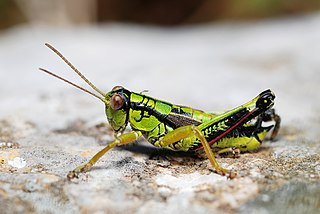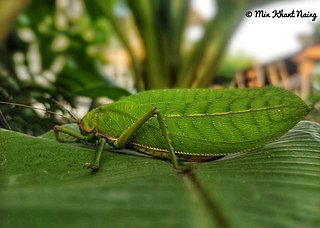
Grylloblattidae, commonly known as the icebugs, or ice crawlers, is a family of extremophile (psychrophile) and wingless insects that live in the cold on top of mountains and the edges of glaciers. They belong, along with Mantophasmatidae, to the order Notoptera. Grylloblattids are wingless insects mostly less than 3 cm long, with a head resembling that of a cockroach, with long antennae and having elongated cerci arising from the tip of their abdomen. They cannot tolerate warmth and many species have small distribution ranges.

Miramella is a small genus of short-horned grasshoppers in the subfamily Melanoplinae. They are found in Europe and eastern Asia. As of January 2019, Orthoptera Species File lists seven species in three subgenera. The genus was first named in 1932. Miramella is the type genus of the subtribe Miramellina.
The Madygen Formation is a Late Triassic (Carnian) geologic formation and Lagerstätte in the Batken and Osh Regions of western Kyrgyzstan, with minor outcrops in neighboring Tajikistan and Uzbekistan. The conglomerates, sandstones and mudstones of the 560 m (1,840 ft) thick formation were deposited in terrestrial lacustrine, alluvial, fluvial and deltaic environments.

Pseudophyllus titan, the giant false leaf katydid, is a species of leaf-mimic bush-cricket of the subfamily Pseudophyllinae found in the canopy of tropical forests in Mainland Southeast Asia, Bangladesh, northeastern India, and southernmost China (Yunnan). It is among the largest species in the genus Pseudophyllus, which also makes it one of the world's largest Orthoptera, with a typical length of 13 cm (5.1 in) from head to tip of the folded wings and a wingspan of c. 23 cm (9.1 in). Like many other species of crickets and grasshoppers, the male is capable of stridulation, producing a relatively loud and distinctive, bird-like chirp; it usually stridulates ("sings") at night.

The Orthopteran subfamily Aemodogryllinae contains about sixteen genera of camel crickets. It was named after AemodogryllusAdelung, 1902 - which is now considered a subgenus of Diestrammena.
Microtachycines is a genus of cave or camel crickets in the subfamily Aemodogryllinae and tribe Aemodogryllini. The type species name M. tamdaonensis is based on specimens found in Tam Dao National Park in Vietnam.
Tamdaotettix is a genus of cave or camel crickets in the subfamily Aemodogryllinae and tribe Diestramimini. Originating in Asia, species have been found in the Indo-China region.
Megadiestramima is a genus of cave or camel crickets in the subfamily Aemodogryllinae and tribe Diestramimini. Originating in Asia, species have been found in the Indo-China region.
Anacranae is a genus of grasshoppers in the subfamily Catantopinae and tribe Gereniini. Species can be found in Indo-China, including peninsular Malaysia, where the type species is found.
Geinitzia is an extinct genus of flying insects belonging to the order Reculida and family Geinitziidae. Species belonging to the genus lived from the Permian to the Jurassic and have been found in China, Germany, Kyrgyzstan, the United Kingdom, Japan, and Russia.
Galloisiana is a genus of insects in the family Grylloblattidae found in East Asia. It contains 12 species.
Namkungia is a genus of cave-dwelling insects in the family Grylloblattidae found in Korea. It contains 2 species, both of which are found in caves in Jeongseon County, Gangwon Province, South Korea.
Grylloblattella cheni is a species of insect in the family Grylloblattidae. Its type locality is Ake Kule Lake in Xinjiang, China.
Grylloblattella pravdini is a species of insect in the family Grylloblattidae. Its type locality is Teletskoye Lake, Altai Republic, Russia.
Grylloblattella sayanensis is a species of insect in the family Grylloblattidae found in the Sayan Mountains of Russia. Its type locality is Sambyl Pass in Siberian Russia.
Galloisiana kiyosawai is a species of insect in the family Grylloblattidae that is endemic to Japan. Its type locality is Hirayu Warm Springs, Japan.

Galloisiana nipponensis is a species of insect in the family Grylloblattidae that is endemic to Japan. Its type locality is Lake Chūzenji, Japan.
Galloisiana notabilis is a species of insect in the family Grylloblattidae that is endemic to southern Japan. Its type locality is Nagasaki Prefecture, Japan.
Galloisiana yuasai is a species of insect in the family Grylloblattidae that is endemic to Japan. Its type locality is Tokugo Pass, Japan.
Galloisiana yezoensis is a species of insect in the family Grylloblattidae that is endemic to Japan. Its type locality is Miyazaki Pass, Japan.



